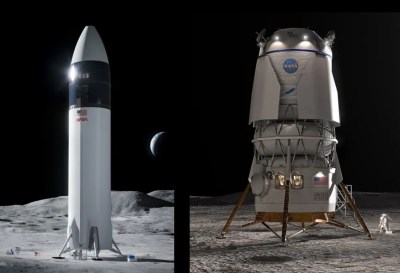It’s been a busy week in space news, and very little of it was good. We’ll start with the one winner of the week, Firefly’s Blue Ghost Mission 1, which landed successfully on the Moon’s surface on March 2. The lander is part of NASA’s Commercial Lunar Payload Services program and carries ten scientific payloads, including a GPS/GNSS receiver that successfully tracked signals from Earth-orbiting satellites. All of the scientific payloads have completed their missions, which is good because the lander isn’t designed to withstand the long, cold lunar night only a few days away. The landing makes Firefly the first commercial outfit to successfully soft-land something on the Moon, and being the first at anything is always a big deal.
starship27 Articles
Hackaday Links: January 19, 2025
This week, we witnessed a couple of space oopsies as both Starship and New Glenn suffered in-flight mishaps on the same day. SpaceX’s Starship was the more spectacular, with the upper stage of the seventh test flight of the full stack experiencing a “rapid unscheduled disassembly” thanks to a fire developing in the aft section of the stage somewhere over the Turks and Caicos islands, about eight and a half minutes after takeoff from Boca Chica. The good news is that the RUD happened after first-stage separation, and that the Super Heavy booster was not only able to safely return to the pad but also made another successful “chopsticks” landing on the tower. Sorry, that’s just never going to get old.
On the Bezos side of the billionaire rocket club, the maiden flight of Blue Origin’s New Glenn ended with the opposite problem. The upper stage reached orbit, but the reusable booster didn’t make it back to the landing barge parked off the Bahamas. What exactly happened isn’t clear yet, but judging by the telemetry the booster was coming in mighty fast, which may indicate that the engines didn’t restart fully and the thing just broke up when it got into the denser part of the atmosphere.
Measuring The Mighty Roar Of SpaceX’s Starship Rocket
SpaceX’s Starship is the most powerful launch system ever built, dwarfing even the mighty Saturn V both in terms of mass and total thrust. The scale of the vehicle is such that concerns have been raised about the impact each launch of the megarocket may have on the local environment. Which is why a team from Brigham Young University measured the sound produced during Starship’s fifth test flight and compared it to other launch vehicles.
Published in JASA Express Letters, the paper explains the team’s methodology for measuring the sound of a Starship launch at distances ranging from 10 to 35 kilometers (6 to 22 miles). Interestingly, measurements were also made of the Super Heavy booster as it returned to the launch pad and was ultimately caught — which included several sonic booms as well as the sound of the engines during the landing maneuver.
Continue reading “Measuring The Mighty Roar Of SpaceX’s Starship Rocket”
Hackaday Links: October 20, 2024
When all else fails, there’s radio. Hurricane Helene’s path of destruction through Appalachia stripped away every shred of modern infrastructure in some areas, leaving millions of residents with no ability to reach out to family members or call for assistance, and depriving them of any news from the outside world. But radio seems to be carrying the day, with amateur radio operators and commercial broadcasters alike stepping up to the challenge.
Hackaday Links: March 17, 2024
A friend of ours once described computers as “high-speed idiots.” It was true in the 80s, and it appears that even with the recent explosion in AI, all computers have managed to do is become faster. Proof of that can be found in a story about using ASCII art to trick a chatbot into giving away the store. As anyone who has played with ChatGPT or its moral equivalent for more than five minutes has learned, there are certain boundary conditions that the LLM’s creators lawyers have put in place to prevent discussion surrounding sensitive topics. Ask a chatbot to deliver specific instructions on building a nuclear bomb, for instance, and you’ll be rebuffed. Same with asking for help counterfeiting currency, and wisely so. But, by minimally obfuscating your question by rendering the word “COUNTERFEIT” in ASCII art and asking the chatbot to first decode the word, you can slip the verboten word into a how-to question and get pretty explicit instructions. Yes, you have to give painfully detailed instructions on parsing the ASCII art characters, but that’s a small price to pay for forbidden knowledge that you could easily find out yourself by other means.
How Different Are SpaceX Thermal Tiles From The Space Shuttle’s?
When SpaceX first showed off the thermal tiles on its Starship spacecraft that should keep it safe when re-entering the Earth’s atmosphere towards the loving embrace of the chopsticks on the launch tower, some similarity to the thermal tiles on NASA’s now retired Space Shuttle Orbiter was hard to miss.

Yet how similar are they really? That’s what the [Breaking Taps] channel on YouTube sought to find out, using an eBay-purchased chunk of Shuttle thermal tile along with bits of Starship tiles that washed ashore following the explosive end to the vehicle’s first integrated test last year.
To answer the basic question: the SpaceX engineers responsible for the Starship thermal tiles seem to have done their homework. An analysis of not only the structure of the fibrous material, but also the black IR-blocking coating, shows that the Starship tiles are highly reminiscent of the EATB (introduced in 1996) tiles with TUFI (toughened unipiece fibrous insulation) coatings with added molybdenum disilicide, which were used during the last years of the Shuttle program.
TUFI is less fragile than the older RCG (reaction cured glass) coating, but also heavier, which is why few TUFI tiles were used on the Shuttles due to weight concerns. An oddity with the Starship tiles is that they incorporate many very large fibers, which could be by design, or indicative of something else.
Continue reading “How Different Are SpaceX Thermal Tiles From The Space Shuttle’s?”
Artemis’ Next Giant Leap: Orbital Refueling
By the end of the decade, NASA’s Artemis program hopes to have placed boots back on the Moon for the first time since 1972. But not for the quick sightseeing jaunts of the Apollo era — the space agency wants to send regular missions made up of international crews down to the lunar surface, where they’ll eventually have permanent living and working facilities.
The goal is to turn the Moon into a scientific outpost, and that requires a payload delivery infrastructure far more capable than the Apollo Lunar Module (LM). NASA asked their commercial partners to design crewed lunar landers that could deliver tens of tons of to the lunar surface, with SpaceX and Blue Origin ultimately being awarded contracts to build and demonstrate their vehicles over the next several years.

At a glance, the two landers would appear to have very little in common. The SpaceX Starship is a sleek, towering rocket that looks like something from a 1950s science fiction film; while the Blue Moon lander utilizes a more conventional design that’s reminiscent of a modernized Apollo LM. The dichotomy is intentional. NASA believes there’s a built-in level of operational redundancy provided by the companies using two very different approaches to solve the same goal. Should one of the landers be delayed or found deficient in some way, the other company’s parallel work would be unaffected.
But despite their differences, both landers do utilize one common technology, and it’s a pretty big one. So big, in fact, that neither lander will be able to touch the Moon until it can be perfected. What’s worse is that, to date, it’s an almost entirely unproven technology that’s never been demonstrated at anywhere near the scale required.
Continue reading “Artemis’ Next Giant Leap: Orbital Refueling”














